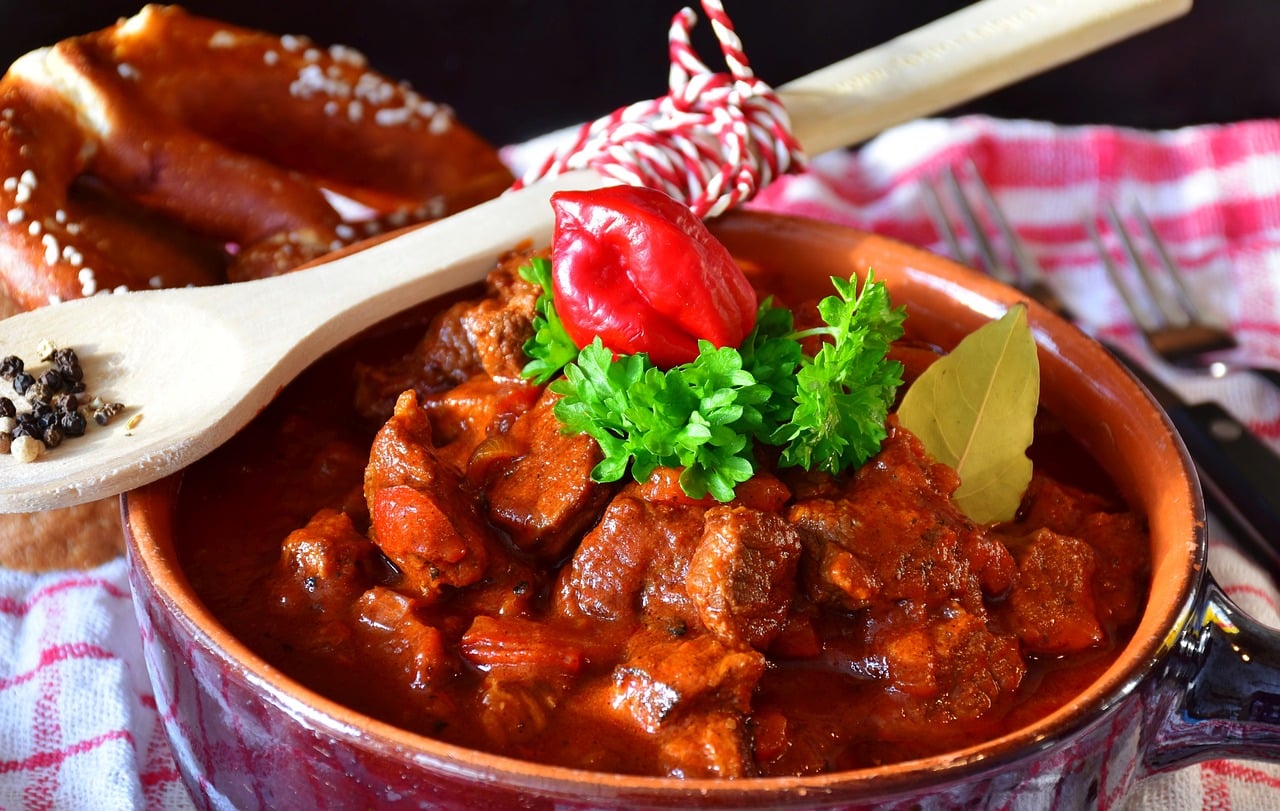
Goulash, a hearty stew of meat and vegetables, is the national dish of Hungary. It’s a culinary symbol that represents the country’s history, culture, and traditions. This article delves into the origins of goulash, its ingredients, preparation process, variations across Hungary, and its influence on global cuisine.
Our team at Remitly created this guide as part of our series that celebrates the cuisine of our customers around the world.
The Origins of Goulash
Goulash traces its roots back to 9th-century Hungarian shepherds. They dried meat in the sun and packed it into bags made from sheep’s stomachs for storage. When needed, they added water to make soup. Over time, this simple shepherd’s meal evolved into today’s complex goulash.
The name “goulash” comes from “gulyás,” which means “herdsman” in Hungarian. The dish was a staple food for herdsmen who drove their cattle across Hungary in search of better pastures.
Ingredients Used in Traditional Goulash
Traditional goulash is a harmonious blend of simple ingredients. Beef is often used as the main protein source but pork or poultry can also be used. Vegetables like potatoes and carrots add texture while onions give it a sweet undertone.
The defining ingredient is paprika—a spice made from ground red peppers—which gives goulash its characteristic color and flavor. Paprika arrived in Hungary in the 16th century via Ottoman routes and quickly became an integral part of Hungarian cuisine.
A Simple Goulash Recipe
Goulash is a dish that invites experimentation, but here’s a basic recipe to get you started. This version serves four.
Ingredients
- 500g of beef, cut into chunks
- 2 large onions, chopped
- 2 cloves of garlic, minced
- 3 medium potatoes, diced
- 2 carrots, sliced
- 1 bell pepper, chopped
- 4 tablespoons of paprika
- 1 teaspoon caraway seeds
- Salt and pepper to taste
- Water or broth as needed
Instructions
- Heat oil in a pot over medium heat. Add onions and sauté until golden brown.
- Add the beef chunks and brown on all sides.
- Stir in the garlic, paprika, caraway seeds, salt and pepper.
- Pour in enough water or broth to cover the meat and bring to a boil.
- Reduce heat to low and let it simmer for about an hour.
- Add potatoes, carrots and bell pepper then continue simmering until vegetables are tender—about another half hour.
- Adjust seasoning if necessary then serve hot with fresh bread or nokedli.
Variations of Goulash Across Hungary
Goulash varies across Hungary, reflecting regional preferences and available ingredients. In the northern mountains, goulash often includes beans while in the southern plains, it’s typically spicier due to a generous use of paprika.
In Szeged, known for its paprika production, goulash is made with a mix of meats including beef, pork, and mutton. Meanwhile in Budapest, goulash is often served as a soup rather than a stew.
How Goulash is Served and Enjoyed
Goulash can be enjoyed as a main course or as an appetizer. It’s traditionally served with fresh bread on the side to mop up every last bit of the flavorful broth. Some prefer it with nokedli—small Hungarian dumplings—or boiled potatoes.
In Hungary, goulash isn’t just food—it’s comfort and nostalgia served in a bowl. It’s shared during family gatherings and festive occasions symbolizing unity and warmth.
Influence of Hungarian Goulash on Global Cuisine
Hungarian goulash has left its mark on global cuisine. Many countries have their own versions inspired by this hearty stew. In Austria and Germany, for instance, gulasch is popular while in America it’s been adapted into “goulash” pasta dishes.
Despite these variations, they all pay homage to the original Hungarian dish that has warmed hearts and bellies for centuries.
Exploring the Future of Goulash
As we look to the future, goulash continues to evolve while staying true to its roots. Chefs are experimenting with new ingredients and techniques, creating modern interpretations of this classic dish.
Yet, no matter how it changes, goulash will always remain a symbol of Hungarian culture—a testament to its enduring appeal and the power of food in bringing people together.
The Broader Cuisine of Hungary
Hungarian cuisine is diverse and flavorful with dishes that reflect its history and geography.
Influences on Hungarian Cuisine
Hungary’s location at the crossroads of Europe has shaped its cuisine significantly—it’s influenced by neighboring countries like Austria, Slovakia, Romania and Serbia.
The Ottoman occupation introduced new ingredients like eggplant while Austrian rule brought pastries into Hungarian kitchens.
Common Ingredients in Hungarian Cuisine
Paprika is ubiquitous in Hungarian cooking—it flavors everything from soups to stews to sauces. Other common ingredients include meats (especially pork), dairy products like sour cream and cheese, grains such as wheat and cornmeal along with a variety of fruits and vegetables.
Popular Hungarian Dishes
Beyond goulash, Hungary is known for dishes like paprikás (meat stewed in a creamy paprika sauce), töltött káposzta (stuffed cabbage rolls), and lecsó (a vegetable stew similar to ratatouille).
Desserts are also a highlight with treats like Dobos torte—a layered sponge cake with chocolate buttercream and caramel topping—and kürtőskalács, a sweet spiral-shaped pastry.
Hungarian cuisine offers a rich tapestry of flavors that tell the story of its past while continuing to evolve and delight palates around the world.
Visit the homepage, download our app, or check out our Help Center to get started.